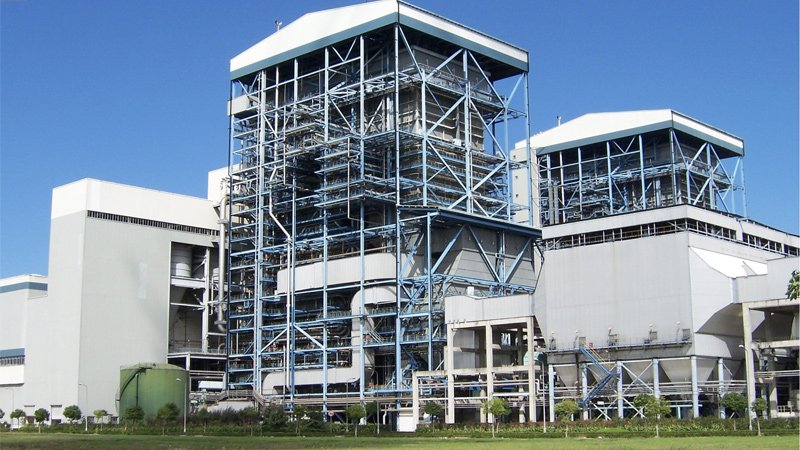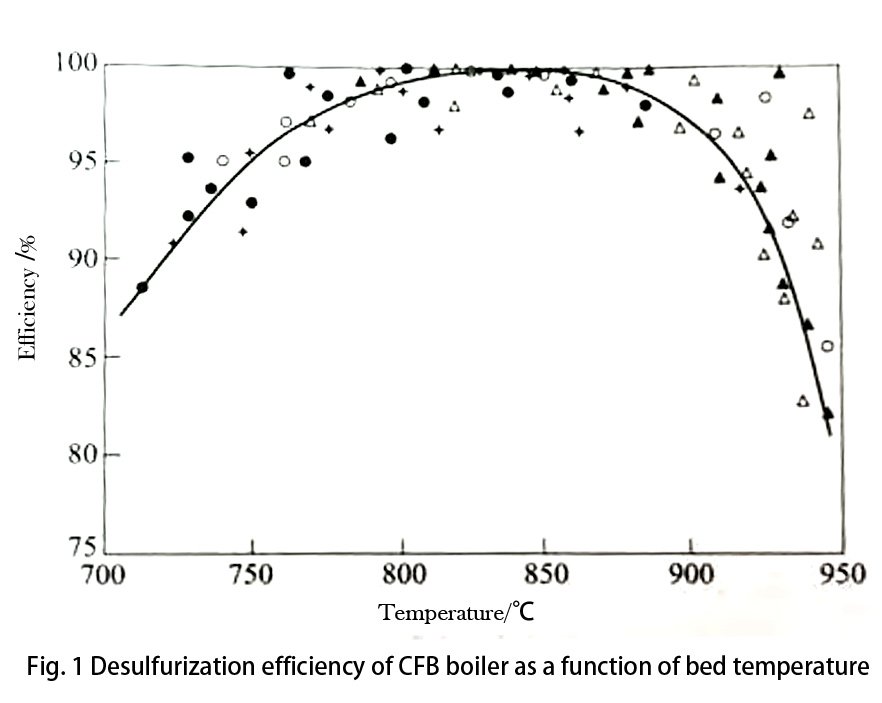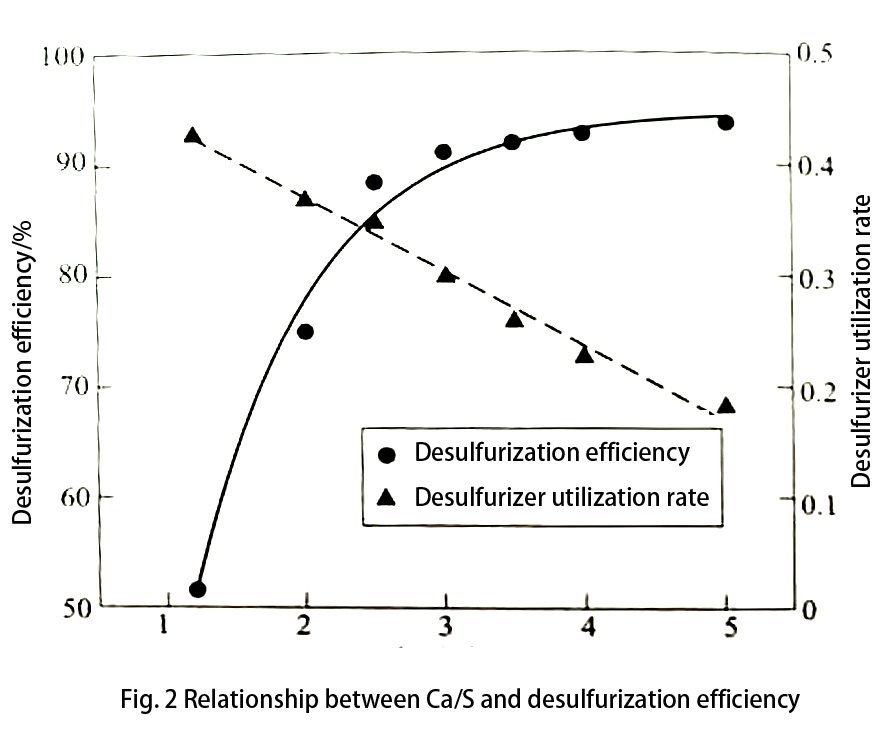The operating temperature range for a typical Circulating Fluidized Bed Boiler (CFB Boiler) bed is generally maintained between 850°C and 900°C. This temperature range plays a critical role in ensuring the thorough calcination and decomposition of limestone, a pivotal process for generating calcium oxide. Within the furnace’s flue gas environment, limestone functions as the primary agent for desulfurization. It reacts with sulfur dioxide produced during coal combustion, leading to the formation of solid sulfur compounds. These compounds are subsequently either entrained in the bottom slag or fly ash and are expelled from the boiler. This aspect underscores the economic advantage of employing a cost-effective desulfurization process in the context of a CFB Boiler.
Through meticulous optimization of in-furnace desulfurization technologies, the achievable desulfurization efficiency in CFB Boilers can range between 90% and 95%. The most recent national emission standards outlined in GB13223-201 “Emission Standards for Air Pollutants from Thermal Power Plants” have introduced more stringent regulations for sulfur dioxide (SO2) emissions. For new coal-fired units, aside from specific regions such as Guangxi Zhuang Autonomous Region, Chongqing Municipality, Sichuan Province, and Guizhou Province, where a limit of 200 mg/Nm3 is enforced, the majority of other areas adhere to an emission limit of 100 mg/Nm3. Key areas have even stricter limits, with an emission ceiling of 50 mg/Nm3.
Given the adoption of the 50 mg/Nm3 limit in pivotal areas, the design and operation of new fluidized bed boilers across most of the nation necessitate the integration of both in-furnace calcium desulfurization (FFD) and out-of-furnace desulfurization (OFD) techniques. This comprehensive approach aligns with the current national environmental protection standards. In-furnace desulfurization is capable of mitigating approximately 90% of the original emissions, significantly lowering the dew point temperature of the flue gas, mitigating corrosion on low-temperature heating surfaces at the tail end, and concurrently curbing investment expenses associated with external desulfurization methods.

Section: Limestone Desulfurization Process in Circulating Fluidized Bed Boilers (CFB Boilers)
The desulfurization process within the furnace of a Circulating Fluidized Bed Boiler (CFB Boiler) involves intricate chemical reactions with limestone. These reactions are defined by the following equations:
Equation 1: CaCO3 → CaO + CO2
Equation 2: 2CaO + 2SO2 + O2 → 2CaSO4
Through high-temperature calcination, limestone undergoes a transformation where carbon dioxide is liberated from calcium carbonate, leaving behind a structurally porous form of limestone (CaO). In the combustion atmosphere, the diffusion of flue gas components, sulfur dioxide (SO2), and oxygen (O2), becomes intricate within the microporous structure of the limestone. This leads to non-catalyzed gas-solid reactions occurring on the CaO’s microporous surface, resulting in the generation of CaSO4.
Circulating Fluidized Bed Boilers (CFB Boilers) encompass distinctive technical traits that render furnace spray limestone desulfurization a viable option. The incorporation of high-efficiency cyclone separators enables the capture of minute limestone particles, thereby extending their residence time within the furnace. This extension of reaction time is facilitated by the collision and mixing of these particles within the larger particle bed of the furnace, leading to the erosion of the limestone particles’ surfaces. This erosion aids in the creation of an isolation layer composed of CaSO4, wrapping the particles and generating a renewed CaO surface. Consequently, the utilization efficiency of limestone is enhanced.
Moreover, the CFB Boiler design employs both internal and external circulating loops, which function within a temperature range of 850°C to 900°C. This temperature range coincides precisely with the optimal window for limestone calcination and desulfurization reactions. These conditions play a pivotal role in fostering heightened desulfurization efficiency.
Section: Strategies for Enhancing Furnace Desulfurization Efficiency
The enhancement of furnace desulfurization efficiency is a result of comprehensive research into the desulfurization characteristics of fluidized bed boilers, along with a thorough evaluation of practical operational scenarios. This analysis sheds light on the pivotal factors that exert influence on in-furnace desulfurization.
Factor 1: Uniform Limestone Feeding
The lower section of the circulating fluidized bed boiler (CFB Boiler) contains a dense phase region characterized by vigorous particle movement, facilitating efficient heat and mass transfer. Consequently, the distribution of sulfur dioxide (SO2) within the flue gas is generally assumed to be relatively uniform across the furnace cross-section. Correspondingly, the introduction of limestone into the furnace necessitates adherence to uniform feeding practices. Primary limestone feeding points within the fluidized bed boiler include the coal feed port, secondary air outlet, and return leg.
For scenarios where furnace desulfurization efficiency requirements are relatively low, coarse limestone can be introduced through the coal feed port. However, due to limitations in mechanical mixing, the uniformity of coal-limestone mixture tends to be suboptimal.
Limestone powder, on the other hand, is typically introduced through the secondary air inlet, where it undergoes dispersion via secondary air broadcasting. This approach significantly enhances the uniformity of limestone distribution. As a result, limestone particles effectively come into contact with the flue gas, a prerequisite for achieving robust desulfurization efficiency.
An alternative method involves the introduction of limestone through the return leg. Here, limestone mixes with return ash and enters the furnace chamber together. This approach ensures the comprehensive dispersion of limestone and return ash, thereby achieving optimal uniformity and maximizing desulfurization efficiency.
Factor 2: Limestone Particle Size
The influence of limestone particle size on desulfurization efficiency within the furnace of a CFB boiler can be delineated into two primary aspects:
Aspect 1: Material Balance Consideration
Diverse particle sizes of limestone engender pronounced differences in inventory and residence time within the furnace chamber. From a material balance perspective, these disparities are noteworthy. Limestone particles of varying sizes exhibit distinct behaviors in terms of their distribution and duration within the furnace environment.
Aspect 2: Chemical Reaction Perspective
When viewed through the lens of chemical reactions, the particle size of limestone contributes significantly to the effectiveness of the desulfurization process. The degree of reaction in terms of desulfurization varies significantly across different limestone particle sizes.
In general, smaller limestone particles offer heightened pore space post-calcination, resulting in larger specific surface areas. This, in turn, translates to higher reaction rates during the early stages of the desulfurization process. Empirical testing and practical applications have consistently demonstrated that reducing limestone particle size correlates positively with enhanced desulfurization efficiency within the furnace of a circulating fluidized bed boiler (CFB Boiler).
However, it’s important to note that excessively small limestone particle sizes can lead to undesirable consequences. For instance, a reduction in particle size could lead to a higher likelihood of limestone escaping the system. This implies that unreacted limestone might evade capture by the separator, hampering the feasibility of reusing limestone. Furthermore, such minute particles tend to have shorter residence times within the furnace, compromising the efficiency of the desulfurization process.
In essence, while the adoption of finer limestone particle sizes can promote higher desulfurization efficiency, a judicious balance must be struck to ensure optimal outcomes without inadvertently impeding the overall desulfurization process.
Factor 3: External Circulation Parameters, including Separator Efficiency
An integral aspect that significantly impacts both the efficiency of desulfurization within the furnace and the consumption of desulfurizing agents pertains to the duration during which fine limestone particles remain within the furnace for reactive purposes. This temporal dimension holds substantial importance.
Within widely-sieved limestone powder, the presence of fine particles is inherent. Moreover, during the reaction process, larger limestone particles undergo collisions and abrasions, giving rise to the generation of additional fine particles. These fine particles exert a considerable influence on the efficacy of the desulfurization reaction.
The separator, a pivotal component responsible for maintaining the external circulation performance and ensuring the consistent and stable operation of a circulating fluidized bed boiler (CFB Boiler), assumes a critical role. The separator’s efficiency plays a decisive role in this regard. Enhanced separator efficiency translates to an augmented capacity for capturing circulating materials, including fine limestone particles, which are subsequently reintroduced into the boiler chamber for repeated combustion and reaction.
A higher efficiency of the separator facilitates the extension of residence time for fine limestone particles within the furnace. Additionally, fine particles boast greater reactivity in desulfurization reactions as opposed to coarser particles. Consequently, an improvement in the efficiency of the desulfurization reaction within the furnace of a circulating fluidized bed boiler (CFB Boiler) is achieved through the joint amplification of separator efficiency and the prolonged presence of finely divided limestone particles.
Factor 4: Boiler Bed Temperature
Observations derived from both experimental test beds and an array of operational engineering scenarios have consistently demonstrated a distinct pattern in furnace desulfurization efficiency relative to the variation in boiler bed temperature. This trend typically entails an initial increase in desulfurization efficiency followed by a subsequent decline. Remarkably, an optimal value manifests at approximately 850°C.
The consensus within the field is that bed temperature plays a crucial role. Operating within a bed temperature lower than 800°C yields a noticeable reduction in the pace of limestone calcination and the reaction between solid sulfur and CaO. These reactions constitute essential components of the desulfurization process. The slowed rates of these reactions at lower temperatures invariably lead to a compromised desulfurization efficiency.
On the contrary, bed temperatures exceeding the optimal range can similarly undermine desulfurization efficiency. This suggests a delicate equilibrium within which the optimal bed temperature of around 850°C fosters the most effective and efficient desulfurization reactions within the furnace.
Therefore, meticulous control of boiler bed temperature to maintain it within the optimal range is imperative for sustaining high desulfurization efficiency within the context of circulating fluidized bed boilers (CFB Boiler).

Factor 5: Calcium-Sulfur Molar Ratio
The calcium-sulfur molar ratio (Ca/S) emerges as a crucial parameter for assessing the extent and effectiveness of limestone utilization as a desulfurization agent within the furnace. This ratio holds the ability to intuitively reflect both the quantity and efficiency with which limestone serves its desulfurization role. As a result, it constitutes a pivotal metric for gauging the overall desulfurization impact within the furnace.
With all other reaction conditions held constant, the Ca/S ratio directly influences the outcome. A higher Ca/S ratio translates to an increased concentration of limestone reactants. Consequently, this elevated concentration enhances the interface between the desulfurizer and sulfur dioxide (SO2) present in the flue gas. This augmented contact zone, in turn, accentuates the efficiency of the desulfurization process.
By adopting a strategy that maintains an optimal Ca/S ratio, operators can optimize the utilization of limestone as a desulfurization agent. This, in turn, ensures that the desulfurization reactions within the furnace are not only effective but also efficient. The Ca/S ratio, acting as a guide, aids in striking the balance that leads to optimal desulfurization outcomes.

Conclusion
In conclusion, this paper has comprehensively examined the components and factors that exert influence on the dry in-furnace desulfurization process within circulating fluidized bed boilers (CFB Boilers). Through a thorough analysis of the various factors outlined, valuable insights have been gleaned, contributing to a deeper understanding of the intricacies of in-furnace desulfurization.
The discussion has shed light on critical elements such as the uniformity of limestone feeding, limestone particle size, external circulation parameters like separator efficiency, boiler bed temperature, and the calcium-sulfur molar ratio (Ca/S). Each of these factors plays an integral role in shaping the efficiency and effectiveness of the desulfurization process within the furnace.
By delving into these factors and their interactions, this paper has yielded significant implications for the design and operation of in-furnace desulfurization processes. The findings presented herein provide a foundation upon which further advancements and optimizations in CFB Boiler desulfurization can be built.
In essence, this study serves as a valuable resource, offering practical suggestions and insights for enhancing the efficacy of in-furnace desulfurization strategies in the realm of circulating fluidized bed boilers (CFB Boilers).
[Source]GAO Xin-yu, ZHANG Xin, WANG Gang, Technical Discussion on Improving Desulfurization in Circulating fluidized bed boiler(CFB Boiler), Power System Engineering 2023[7]:29-30
DHB Boiler
Discover The Superior Quality And Cutting-Edge Technology Of DHB Boilers. Explore Our Range Of Biomass Boilers, Waste Heat Boilers, And More. Take Your Industrial Operations To New Heights With DHB Boiler.








